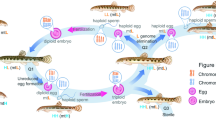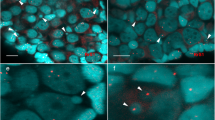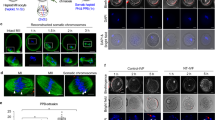Abstract
ADVANCES in knowledge of plant polyploidy, with their theoretical and practical importance, have led to an interest in polyploidy in the animal kingdom. Among invertebrates, polyploidy is a normal phenomenon in some races (for example, Artemia salina1,2, Curculionidæ3, Solenobia4, Trichoniscus5). In vertebrates, a possible polyploid origin of some fish species has been reported6, and there is now a considerable body of literature on natural and induced polyploidy in Amphibia7–12. It would be of interest to extend the study of polyploidy to mammals. The existence of polyploid mammals should throw light on such important problems as, for example, physiological genetics, with special reference to dominance and gene dosage effects in vertebrates11. Information should also be gained on sex determination and developmental processes in general. The existence of polyploid mammals might be of medical and economic interest.
This is a preview of subscription content, access via your institution
Access options
Subscribe to this journal
Receive 51 print issues and online access
$199.00 per year
only $3.90 per issue
Buy this article
- Purchase on Springer Link
- Instant access to full article PDF
Prices may be subject to local taxes which are calculated during checkout
Similar content being viewed by others
References
Artom, C., Mem. R. Accad. Ital., 2, No. 1, 1 (1931).
Gross, F., Naturwiss., 20, 962 (1932).
Suomalainen, E., Hereditas, 33, 29 (1947).
Seller, J., Biol. Zbl., 47, 426 (1927).
Vandel, A., Bull Biol., 62, 164 (1928); 68, 419 (1934).
Swärdson, G., Medd. St. undersöken.-o. försöksanst f. sötvattersfisket, No. 23 (1945).
Fankhauser, G., Proc. Amer. Phil. Soc., 79, 715 (1938).
Fankhauser, G., Quart. Rev. Biol., 20, 20 (1945).
Fischberg, M., Rev. Suisse Zool., 51, 430 (1944).
Fischberg, M., Genetica, 24, 213 (1948).
Fischberg, M., Rev. Suisse Zool., 55, 304 (1948).
Kawamura, T., J. Sci. Hiroshima Univ., Ser. B, Div. 1, 6, 115 (1939).
Pincus, G., and Waddington, C. H., J. Hered., 30, 515 (1939).
Author information
Authors and Affiliations
Rights and permissions
About this article
Cite this article
BEATTY, R., FISCHBERG, M. Spontaneous and Induced Triploidy in Pre-Implantation Mouse Eggs. Nature 163, 807–808 (1949). https://doi.org/10.1038/163807a0
Issue Date:
DOI: https://doi.org/10.1038/163807a0
This article is cited by
-
An experiment on induction of triploidy inEriocheir japonicus hepuensis Dai by heat treatment
Chinese Journal of Oceanology and Limnology (1993)
-
Production of triploidy ingasterosteus aculeatus (L)
Journal of Genetics (1959)
-
Production of Heteroploidy in the Three-Spined Stickleback, Gasterosteus aculeatus (L.)
Nature (1956)
-
Colchicine-induced Heteroploidy in Early Mouse Embryos
Nature (1954)
-
Polyploidy and the sex chromosomes
Acta Biotheoretica (1953)
Comments
By submitting a comment you agree to abide by our Terms and Community Guidelines. If you find something abusive or that does not comply with our terms or guidelines please flag it as inappropriate.



